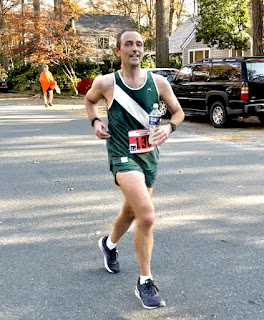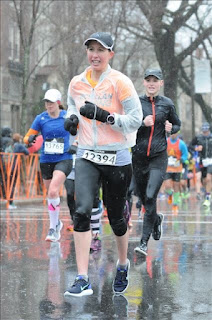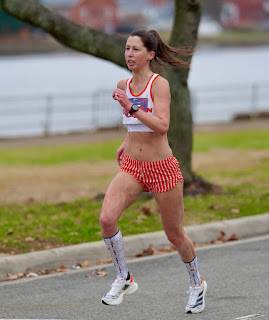I'm very excited to share my first-ever guest blog post! This post is by my husband Greg, blogging about his experience at the Rehoboth Beach Marathon last weekend. He's an excellent writer and makes some insightful points about the challenge of running a marathon. Enjoy!
My Running Journey
Because my running journey is mostly unknown to this audience, I’ll provide a brief introduction. I started running in 2008 to combat the weight gain that came from not being in my early 20’s anymore. Running is one of the things that contributed significantly to meeting and establishing my relationship with my wife, Elizabeth.
My first Marathon was NYC in 2010. I paced it for a 3:40 but painfully bonked my way to a 4:08:xx. I had a decent amount of experience racing other distances prior to that marathon, but was unprepared for the special pain that is unique to the marathon distance. That experience has stuck with me and left me with what I consider to be an appropriate level of respect for (and some fear of) the Marathon.
Since 2010, I’ve run 17 marathons in 12 states. I’ve had a few rough experiences, like NYC, and I’ve had some great races. I’ve learned a few lessons – you have to be smart with pacing; don’t run too fast too soon no matter how good you feel; do just a little more than you think possible; be present in the moment; don’t forget to enjoy the experience; it’s going to hurt at some point; you gotta keep pushing; walking will only make it hurt for longer; no matter what, if you try your best, it’s a win.
The best way I can describe my mental approach to racing a Marathon is trying my best to optimize the competing priorities of the aforementioned lessons. That is the challenge that I find most rewarding.
On Choosing RehobothI have fond memories of the
Rehoboth Seashore Marathon from 2018. On that day I was Elizabeth’s support crew, photographer, and cheering squad. And, as the readers of this blog know, that was a magical day for Elizabeth. It was also a great weekend.
Our hotel was awesome – the Boardwalk Plaza Hotel is right on the beach. The beds are comfortable. They’ve got Macaw birds to greet you in the foyer – “YHELLO!”. They have a pool that is more like a large hot-tub. The pub has a chess set. And, they’re a block away from the start line.
I enjoy the Rehoboth area. The dining options are great. The weather in December is likely to be cool. It’s a ~2.5 hour drive from our house. The course is flat. Logistics are simple. For me, it’s a no-brainer.
TrainingMy preparation for Rehoboth was good. Really good. It wasn’t my hardest-ever training cycle and I didn’t think I was in the best shape of my life, but I had trained consistently. Following the Two Rivers Marathon in late March, I maintained a 30-mile per week base while introducing rowing into my regimen during May and June. My running mileage slowly ramped up starting in July. Ultimately, I ran seven weeks over 50 miles, two of which peaked over 60.
On the mental side of things, I had a couple doubts – some training paces felt harder than I’d wanted, I’ve struggled with sleep, and I was objectively ~5 pounds heavier than ideal. On the flip side, I had one confidence-building long-run, and, of course, I’m smarter and better able to optimize those competing priorities than ever before.
Overall, I think the stress associated with this training cycle and the race anticipation tipped net-negative. However, one thing I pride myself on is knowing that I will do my best regardless of the challenge, so the scales don’t ever tip too far.
Strategy
For every race, you’ve gotta decide if you’re going to go for a PR or not. I knew a PR was a possibility, but not a given, so of course, I decided to go for it. My PR was the Two Rivers Marathon from March 2021. I ran a 3:19:51. For my fitness level, I regarded that as a solid PR. The pace for that race averaged 7:38.
Two Rivers was a 2x out-and-back with the out’s being uphill and the back’s being downhill. That made it tough to come up with an apples-to-apples pacing plan for besting it. Instead of contending with the long and slow inclines/declines of Two Rivers, Rehoboth offered a flat course with combinations of pavement and gravel. Quite different indeed.
I was disappointed with my ability to hold a specific pace during a few training runs this cycle. Also, I know that I have a proclivity to become overzealous during the glory-miles of a marathon and think that my 10K pace is perfectly reasonable. So, smart pacing became the focus.
Elizabeth is the best pacer I know. So, I was quite happy that she decided to register for the Half Marathon so she could pace me for the first ~4.5 miles, which is when the Half and Full Marathon courses follow the same path. Originally, I asked her to pace me at 7:45. She thought I was short-changing myself somewhat with that starting pace. So, given my respect for her opinion, I consulted my ‘do just a little more than you think possible’ lesson and revised that to a 7:40 pace. I understood that meant some of the other lessons may become more relevant, but I know that PRs come when you choose to prioritize optimism over doubts. Ultimately, there’s only one way to find out anyway, so, game-on!
Pre-Race
The night before the race I slept like crap and that’s that. Fitbit gives me credit for almost 3 hours from 9:43 PM to 12:57 AM. The rest is unclear… :(
The morning routine was standard – bagel, coffee, bathroom, outfit, bib. In that order.
The Race
We lined up between the 3:15 Marathon and 1:40 Half Marathon pace groups. The start was lackluster. No national anthem, no countdown, no cannons. Just ‘start’.
Miles 1-4
Miles 1–4 toured the “downtown” Rehoboth area, including the boardwalk, ultimately ending up at the Henlopen State Park, which is where the Half Marathon course splits from the full.
 |
| Mile 4 |
Shortly after starting a spectator called out, “Elizabeth, I follow you on Instagram”! I thought it was cool to see her recognized, but I didn’t realize that was only the tip of the iceberg for this event.
During the first mile, we talked with a guy named Steve who was going for a 3:19:00. We told him I was in that same ballpark and agreed that the two of us were the official 3:19 pace group.
The course narrowed as we entered the boardwalk at mile 2. At the same time, the 1:40 Half Marathon pace group enveloped us. I understand that many people benefit from pace groups, but I find them to be significant nuisances – like cicada broods descending upon a peaceful neighborhood. It’s just too many in too small an area. We had a hard time staying together and maintaining our pace because of all the crowding. We lost Steve completely.
The course widened around mile 3 and we cruised for the rest of our time together. Ultimately, Elizabeth did a great job hitting the pace, which helped me a lot.
Mile 1 – 7:43
Mile 2 – 7:39
Mile 3 – 7:38
Mile 4 – 7:38
Miles 5–7
At mile 4.5 the Half Marathon turned around while the Full Marathon entered Cape Henlopen State Park at Gordons Pond Trail. This section is gravel.
At this point in the race, I had a lot of things on my mind.
It was time to pace myself. I know that a Marathon can be lost in the first 10k but it cannot be won. So, with a first 4 miles right at my PR pace, my target was to be in the mid-7:30’s for the rest of the first half. My idea was that equaling or besting my best pace would produce a PR and the extent to which I was able to best the pace would dictate the magnitude of the PR.
I was excited to be on the same gravel trail that inspired Elizabeth to become the ‘Queen of the Gravel’ back in 2018. Loose gravel can ‘steal’ the energy that is meant to propel a runner forward in favor of sending stones backward, but I didn’t worry because it wasn’t that gravely. Instead I was hoping I’d benefit from the softer surface.
Mostly though, I am happy to say that I appreciated the scenery. It was a combination of pond, marsh, grasses, and dunes. There were hundreds of Canada Geese flying overhead honking for us (that’s how they cheer). It was the type of environment that brings me peace and I loved it.
Mile 5 – 7:32
Mile 6 – 7:31
Mile 7 – 7:41
Miles 8-14
Halfway through mile 8, we transitioned from gravel back to pavement. Mile 8 included a semi-significant hill up to the Fort Miles Interpretive Site where they had cannons and machine guns.
Running back down the other side of the hill inspired me to start going too fast, so I was happy to find Steve around mile 10. We re-established the 3:19:00 pace group of two. He told me he was targeting 7:35 miles, and I was happy to adopt the sensible structure. We ran together through the turn-around at mile 11 and beyond.
Around mile 13, I noticed Steve had fallen behind and I was running next to someone who was 69 years old. He said he told his wife he’d stop running marathons if he could break 3:20. We ran up the mile-14 hill together and he kept up, no-sweat. I hope to be able to run marathons at age 69!
I don’t usually talk to people during races. This one was different and I enjoyed it. There is an inherent bond because we’re all in it together. Enjoying race conversation was part of the ‘experience’ for me this time.
Mile 8 – 7:47
Mile 9 – 7:20
Mile 10 – 7:37
Mile 11 – 7:35
Mile 12 – 7:40
Mile 13 – 7:35
Mile 14 – 7:43
Miles 15 - 18
Mile 15 transitioned us back to the gravel. I had pulled ahead of both Steve and my other friend. No more conversations to keep my mind occupied. I was on my own. The gravel was harder than the pavement and I was tired enough to be sure of that fact this time. Things were starting to hurt.
The honest questions on my mind at this point were – Do you think it’s too early to be hurting? Have you felt like this at this point in any races that have gone well? Is this a clear bonk? Should you stop when you get to Elizabeth at mile 19.5?
Are those honest questions or are they negative self-talk creeping in? That’s an honest question too.
Most importantly, here’s the antidote that I employed - none of those questions matter. Right now, I’m able to maintain my goal pace and I’m doing so. So, that’s what I’m going to keep doing until I physically can’t do that anymore. That’s resolve.
I told myself that gravel sucks and I’ll feel better once I get back to the pavement. That’s hope.
Also, one important distinction I noted is that my energy levels were good. I felt good. It’s just that my leg muscles were getting sore. That’s important because I knew muscle fatigue was to be expected, so it could safely fall into the ‘suck it up buttercup’ category as opposed to the ‘I’m going to pass out’ category, which is much different and not something I’d ignore.
Mile 15 – 7:30
Mile 16 – 7:29
Mile 17 – 7:31
Mile 18 – 7:35
Miles 19 – 21
We transitioned back to the pavement at the end of mile 18. I was eager to see if my hopes of an easier time would come true. Of course, it wasn’t a black-or-white type of thing. Instead, I found myself still hurting, but able to maintain the pace. So it was unclear if the leg-pain would progress more rapidly than I could finish.
Elizabeth planned to be at mile 19.5 cheering, which was a beacon of light for me. It was also a mental pivot-point in the race. After I saw her, I had an out-and-back to do to be done. So, I was able to look forward to seeing her, and then after that, it was just 3.5 miles out-and-back. These are the mental divisions that matter to me during races. . .
 |
| Elizabeth took this photo at 19.5 |
As expected, there she was. She was cheering so much that I couldn’t tell her how happy I was to see her, which somehow seemed more important to me than receiving her well wishes.
I now realize that I have a history of being fooled by the middle miles of previous marathons. I felt great during miles 15 – 20 of Indianapolis only to struggle it in. During Two Rivers however, I spent miles 15 – 20 worrying that I was overdoing it, and then turning around and rocking it in feeling relatively great.
After seeing Elizabeth at 19.5, I realized that I was going to be okay. Despite my legs and back being sore as shit, the fact that I was confidently maintaining my PR goal-pace so late in the race meant that things were going to be okay.
I had a PR in the bag – you know, you hit that point in a race where you finally just “know”. All the doubts and fears about problems are just gone because here you are; you’ve done so much; there’s not much left to do, and you know how you feel. This is it. You got it!
Mile 20, bang! Mile 21, bang! Five more miles? No problem.
Mile 19 – 7:32
Mile 20 – 7:30
Mile 21 – 7:30
Miles 22 – Finish
Miles 22 – 24 were back on a different gravel section. This gravel was different. I think. There were more stones, more crowding, and more little hills and little turns. It was harder.
As soon as I hit the gravel, I lost my ability to keep my pace. I tried as hard as I could, but there was no willing that the clock would accept.
I started doing math – if I can run 7:30 from now on I’ll still PR! I calculated every mile, realizing a slimmer margin as I consistently failed to run 7:30 each time.
I’ve never transitioned from a late-race relief to a realization that I’m sunk before, so this race has that‘first’ for me.
Miles 25 and 26 were back on the pavement. My pace only continued to slow. My energy was good. My resolve was unbreakable. My legs, however, were just not moving like they used to. We’ve all had those dreams where we need to run, but can’t move fast enough. That’s how I finished this race.
Mile 22 – 7:49
Mile 23 – 8:01
Mile 24 – 7:48
Mile 25 – 8:05
Mile 26 – 8:24
Final 0.31 – 8:00
FinishI finished the Rehoboth Seashore Marathon with a time of
3:21:34. That’s my 3rd fastest marathon to date.
Final Thoughts and Key Takeaways
I went for a PR and didn’t get it. If that seems significant then I haven’t communicated my mindset well enough yet.
I started running as a way to keep consistent focus on my fitness. Running is an interest I have shared with my wife for our entire relationship. The only expectation I have for myself is that I try my best. The point is to train and to race. Training is part of living life and races are significant experiences.
So, when I finished, I was happy for two reasons: I tried my best, and I earned a new experience that I am happy with because I did my best. I’m happy with the way I paced this race. I’m happy that I kept kicking despite how hard it felt. And, I have no doubts that I did as well as I could have, so this race is a ‘win’ for me.
Thanks to all the Racing Stripes subscribers for reading my guest blog.
-Greg



















